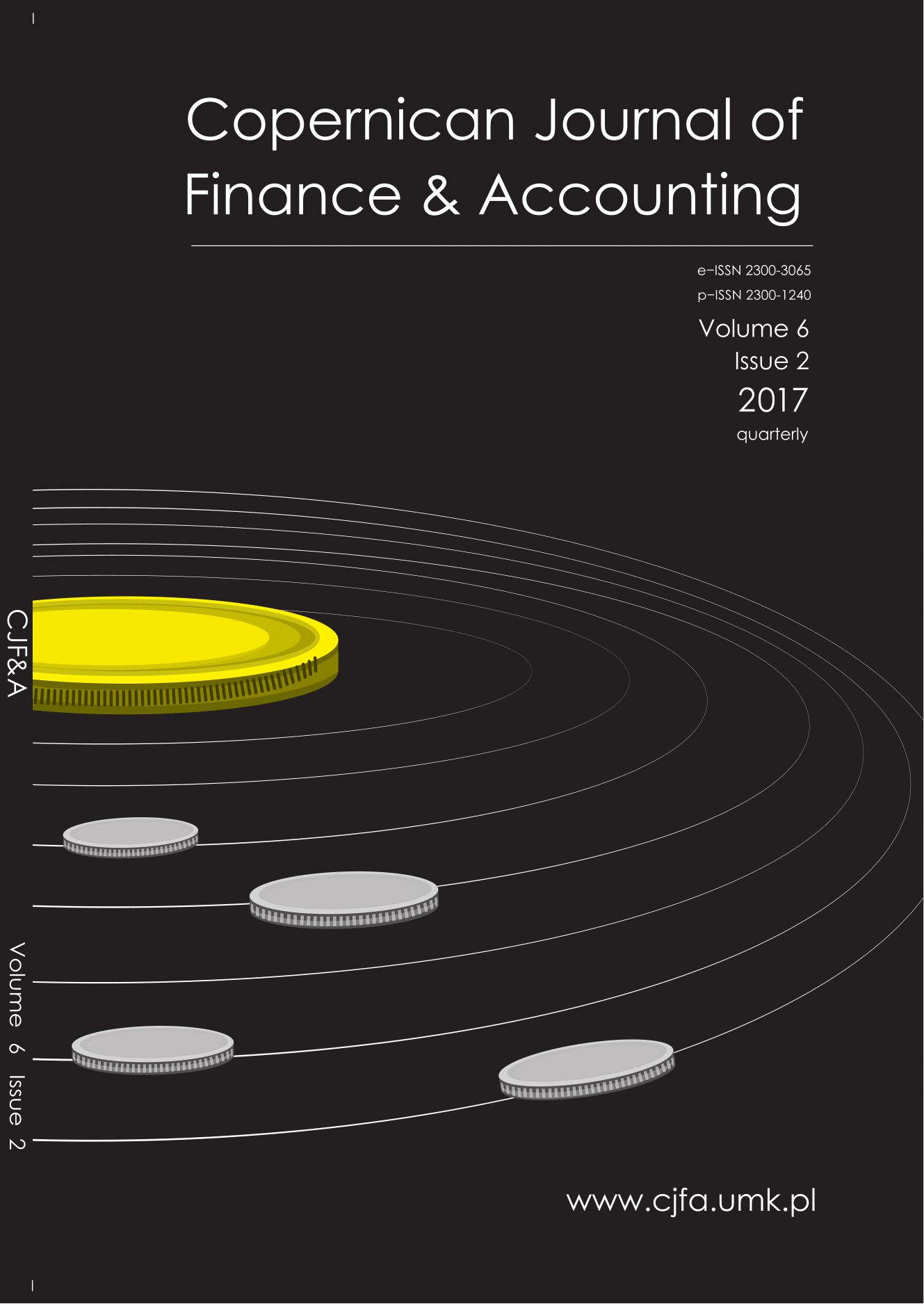HEAVY-TAILED DISTRIBUTIONS AND THE CANADIAN STOCK MARKET RETURNS
DOI:
https://doi.org/10.12775/CJFA.2017.007Słowa kluczowe
Value at Risk, GSPTSE, Skewed t distributionAbstrakt
Many of financial engineering theories are based on so-called “complete markets” and on the use of the Black-Scholes formula. The formula relies on the assumption that asset prices follow a log-normal distribution, or in other words, the daily fluctuations in prices viewed as percentage changes follow a Gaussian distribution. On the contrary, studies of actual asset prices show that they do not follow a log-normal distribution. In this paper, we investigate several widely-used heavy-tailed distributions. Our results indicate that the Skewed t distribution has the best empirical performance in fitting the Canadian stock market returns. We claim the results are valuable for market participants and the financial industry.Bibliografia
Ahn, S., Kim, Joseph H.T., & Ramaswami. V. (2012). A new class of models for heavy tailed distributions in finance and insurance risk. Insurance: Mathematics and Economics, 51(1), 43–52. http://dx.doi.org/10.1016/j.msmatheco.2012.02.002.
Asmussen, S. (2003). Stead-state properties of GI/G/1. Applied Probability and Queues – Stochastic Modelling and Applied Probability, vol. 51, 266–301.
Bradley, B. O., & Taqqu, M. S. (2003). Financial risk and heavy tails. Handbook of Heavy Tailed Distributions in Finance, Chapter 2, vol. 1, 35–103. http://dx.doi.org/10.1016/ B978-044450896-6.50004-2.
Cont, R. (2001). Empirical properties of asset returns: stylized facts and statistical issues. Quantitative Finance, vol. 1, 223–236.
Day, M., & Diamond, M. (2017), GARCH model, heavy tails and the Chinese stock market returns, Working paper.
Glasserman, P., Heidelberger, P., & Shahabuddin, P. (2002). Portfolio Value-at-Risk with heavytailed risk factors. Mathematical Finance, 12(3), 239–269. http://dx.doi.org/10.1111 /1467-9965.00141.
Guo, Zi-Yi (2017a). Heavy-tailed distribution and risk management of equity market tail events. Journal of Risk & Control, vol. 4, 31–41. http://dx.doi.org/10.2139/ssrn.301379.
Guo, Zi-Yi (2017b), A Stochastic Factor Model for Risk Management of Commodity Derivatives, Proceedings of the 7th Economic and Finance Conference, 26–42.
Guo, Zi-Yi (2017c), Models with Short-Term Variations and Long-Term Dynamics in Risk Management of Commodity Derivatives, mimeo.
Guo, Zi-Yi (2017d). How Information Is Transmitted across the Nations? An Empirical Investigation of the US and Chinese Commodity Markets. Global Journal of Management and Business Research, 17(2), 1–11.
Hansen, B. (1994). Autoregressive conditional density estimation. International Economic Review, vol. 35, 705–730. http://dx.doi.org/10.2307/2527081.
Huber-Carol, C., Balakrishnan, N., Nikulin, M., & Mesbah, M. (2002). Goodness-of-Fit Tests and Model Validity, Springer.
Ibragimov, R. (2009). Heavy-tailed densities. The New Palgrave Dictionary of Economics Online.
IMF (2014). Canada financial sector stability assessment. International Monetary Fund Country Report No. 14/29.
Karolyi, G. A. (1995). A multivariate GARCH model of international transmissions of stock returns and volatility: the case of the United States and Canada. Journal of Business & Economic Statistics, 13(1), 11–25. http://dx.doi.org/10.2307/1392517.
Maree, A. (2017), Regulatory requirements, risk management and the equity market in New Zealand, Working paper.
Maree, A., Carr, G., & Howard, J. (2017). A new class of heavy-tailed distribution in GARCH models for the silver returns, Journal of Progressive Research in Social Sciences, 5(2), 364–368.
Mittnik, S., & Paolella, M. S. (2003). Prediction of financial downside-risk with heavytailed conditional distributions. Handbook of Heavy Tailed Distributions in Finance, Chapter 9, vol. 1, 385–404.
Park, T. H., & Switzer, L. N. (1995). Bivariate GARCH estimation of the optimal hedge ratios for stock index futures: A note. The Journal of Futures Markets, vol. 15, 61–67. http://dx.doi.org/10.1002/fut.3990150106.
Prause, K. (1999). The generalized hyperbolic model: estimation, financial derivatives, and risk measures. Ph.D. Dissertation.
Ramchand, L., & Susmel, R. (1998). Volatility and cross correlation across major stock markets. Journal of Empirical Finance, 5(4), 397–416. http://dx.doi.org/10.1016/ S0927-5398(98)0003-6.
Sadorsky, P. (1999). Oil price shocks and stock market activity. Energy Economics, 21(5), 449–469. http://dx.doi.org/10.1016/S0140-9883(99)00020-1.
Taeger, D. & Kuhnt, S. (2014). Goodness-of-fit tests. Statistical Hypothesis Testing with SAS and R, Wiley Online Library.
Theodossiou, P., & Unro, L. (1993). Mean and volatility spillovers across major national stock markets: further empirical evidence. The Journal of Financial Research, 16(4), 337–350. http://dx.doi.org/10.1111/j.1475-6803.1993.tb00152.x.
Pobrania
Opublikowane
Jak cytować
Numer
Dział
Statystyki
Liczba wyświetleń i pobrań: 542
Liczba cytowań: 0



